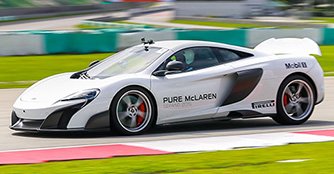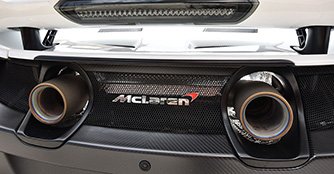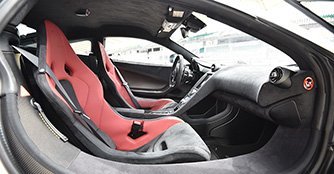McLaren 675LT 3.8 (A) First Drive Review
28 Dec 2015|15,736 views
Together with the 650S, the McLaren 675LT forms the Super Series in the British sports carmaker's lineup. If you haven't already guessed from pictures, the new car is a hardcore version of the 650S and spiritual successor to the iconic F1 GTR Longtail (LT) endurance racer of the 90s.
With a limited production run of 500 cars, this exotic car bridges the gap between the 650S and the McLaren P1 hypercar.
Exterior
On the outside, the 675LT is characterised by an aggressive front bumper, new side skirts with additional air inlet and wider side air intakes. Other standout visual differences from the 650S include a louvered rear window, a contoured P1-like rear fascia with thin horizontal LED taillights and two huge titanium exhaust pipes.
Interestingly, the sculptural elements of the car come off as more technical than artistic - as if they were created by some precise artificial intelligence. If the rare car was on the streets, it would have no problem drawing stares from every lucky guy and girl with quick enough reflexes to catch sight of it.
 |
For a car with the LT name though, it has a pretty short tail, compared with the exaggerated rear ends on the racing versions of the F1 model of the 90s. The 675LT isn't actually any longer than the 650S, just 34mm longer than the latter, but it does get a considerably larger pop-up air brake.
That spoiler may not be humongous, but it has been heavily redesigned, as is everything rear of the B-pillar. Whereas the 650S carried over the tail end of the original 12C model, this one has been restyled more in keeping with the extravert nose, giving the car a more integrated look.
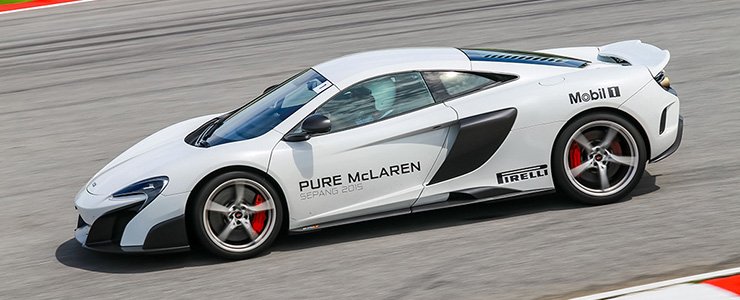 |
Interior
The term 'track-focused' should give a hint as to what's to be found inside the 675LT. The cabin retains the same layout as the 650S' but luxury takes a backseat to weight savings here, starting with the air-conditioning - there is none. You can have it installed at no extra cost if you should be so fortunate as to climb behind the wheel.
Luckily for us, it was fitted in our test car to cater to Malaysia's tropical weather and the air-con controls are integrated with the central touchscreen system for further weight savings.
It's all business in here with the majority of surfaces covered in carbon fibre trim, and most of those that aren't are trimmed in Alcantara, including the sports seats.
These hard buckets are modelled after those in the P1, and they mercilessly squeeze hips and have exactly zero electronic adjustments. They don't even tilt and are meant to bolt occupants in, keeping them exactly where they should be.
Despite the track-focused setup, the car retains a high level of specification rather than being a conventional 'stripped out' racer. Standard features include a navigation system, DAB Digital radio and a lightweight four-speaker system from audio specialist Meridian, although you probably wouldn't need it.
 |
The Drive
Like any super sports car worthy of the name, the engine is located behind the driver for superior balance. In this case, the thoroughly re-engineered M838TL 3.8-litre twin-turbo V8 is good for a devilish 666bhp and 700Nm of torque.
A seven-speed dual-clutch transmission sends these figures to the rear wheels, hurtling the carbon fibre carriage forward with the slightest of throttle application. Acceleration is relentless and seamless, and the car hits the 100km/h mark in just 2.9 seconds.
Down the straights, it feels a little bit ridiculous to be honest, with never-ending acceleration and even better stopping power, thanks in part to powerful carbon ceramic brakes and the large air brake that pivots almost vertically.
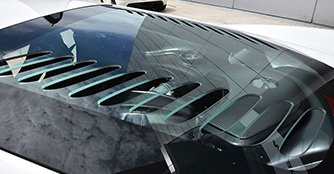
There's a decent scream emitted out of the car's exclusive titanium exhaust too and it's a lot more visceral than the other McLarens.
Aiding to this auditory experience is the newly developed 'Ignition Cut' technology adopted from Formula One, which sees a momentary cut of the fuel spark on gearshift. This actually quickens the shift process, making each one feel instantaneous while unleashing a loud, rifle shot-like crack between gears during full throttle runs.
Like the 650S, the 675LT uses McLaren's ProActive Chassis Control and Brake Steer, but the Normal, Sport and Track settings have all been reworked to deliver edgier responses.
Switch to Sport and, instantly, the stiffer suspension settings make the 675LT feel much more alive but also busier beneath the backside. And if Sport for the drivetrain programme is engaged as well (chassis and drivetrain have their own separate settings), gear cogs becomes faster and far more physical, the exhaust note throatier, the throttle response sharper and harder edged.
Somehow or rather, it delivers a Jekyll and Hyde kind of transformation. On the circuit, the sharper and faster steering rack and tweaked suspension give the 675LT keener turn-in bite and balance mid-corner, and it certainly feels more immediate and flatter as compared to the 650S we've jumped out of a couple of minutes ago.
But regardless of your driving skills, the 675LT is a car that will make you quicker on the track and leave you wanting to push even harder.
Conclusion
Making changes to an already ferociously fast car with impeccable handling makes a package that's seriously hard to argue with. And when you take into account the weight savings, various chassis changes and an uprated brake system, the 675LT is a very fitting tribute to its glorious ancestor.
Unfortunately, all 500 units around the world have already found themselves a home.
Together with the 650S, the McLaren 675LT forms the Super Series in the British sports carmaker's lineup. If you haven't already guessed from pictures, the new car is a hardcore version of the 650S and spiritual successor to the iconic F1 GTR Longtail (LT) endurance racer of the 90s.
With a limited production run of 500 cars, this exotic car bridges the gap between the 650S and the McLaren P1 hypercar.
Exterior
On the outside, the 675LT is characterised by an aggressive front bumper, new side skirts with additional air inlet and wider side air intakes. Other standout visual differences from the 650S include a louvered rear window, a contoured P1-like rear fascia with thin horizontal LED taillights and two huge titanium exhaust pipes.
Interestingly, the sculptural elements of the car come off as more technical than artistic - as if they were created by some precise artificial intelligence. If the rare car was on the streets, it would have no problem drawing stares from every lucky guy and girl with quick enough reflexes to catch sight of it.
For a car with the LT name though, it has a pretty short tail, compared with the exaggerated rear ends on the racing versions of the F1 model of the 90s. The 675LT isn't actually any longer than the 650S, just 34mm longer than the latter, but it does get a considerably larger pop-up air brake.
That spoiler may not be humongous, but it has been heavily redesigned, as is everything rear of the B-pillar. Whereas the 650S carried over the tail end of the original 12C model, this one has been restyled more in keeping with the extravert nose, giving the car a more integrated look.
Interior
The term 'track-focused' should give a hint as to what's to be found inside the 675LT. The cabin retains the same layout as the 650S' but luxury takes a backseat to weight savings here, starting with the air-conditioning - there is none. You can have it installed at no extra cost if you should be so fortunate as to climb behind the wheel.
Luckily for us, it was fitted in our test car to cater to Malaysia's tropical weather and the air-con controls are integrated with the central touchscreen system for further weight savings.
The term 'track-focused' should give a hint as to what's to be found inside the 675LT. The cabin retains the same layout as the 650S' but luxury takes a backseat to weight savings here, starting with the air-conditioning - there is none. You can have it installed at no extra cost if you should be so fortunate as to climb behind the wheel.
Luckily for us, it was fitted in our test car to cater to Malaysia's tropical weather and the air-con controls are integrated with the central touchscreen system for further weight savings.
It's all business in here with the majority of surfaces covered in carbon fibre trim, and most of those that aren't are trimmed in Alcantara, including the sports seats.
These hard buckets are modelled after those in the P1, and they mercilessly squeeze hips and have exactly zero electronic adjustments. They don't even tilt and are meant to bolt occupants in, keeping them exactly where they should be.
Despite the track-focused setup, the car retains a high level of specification rather than being a conventional 'stripped out' racer. Standard features include a navigation system, DAB Digital radio and a lightweight four-speaker system from audio specialist Meridian, although you probably wouldn't need it.
The Drive
Like any super sports car worthy of the name, the engine is located behind the driver for superior balance. In this case, the thoroughly re-engineered M838TL 3.8-litre twin-turbo V8 is good for a devilish 666bhp and 700Nm of torque.
A seven-speed dual-clutch transmission sends these figures to the rear wheels, hurtling the carbon fibre carriage forward with the slightest of throttle application. Acceleration is relentless and seamless, and the car hits the 100km/h mark in just 2.9 seconds.
Down the straights, it feels a little bit ridiculous to be honest, with never-ending acceleration and even better stopping power, thanks in part to powerful carbon ceramic brakes and the large air brake that pivots almost vertically.
There's a decent scream emitted out of the car's exclusive titanium exhaust too and it's a lot more visceral than the other McLarens.
Aiding to this auditory experience is the newly developed 'Ignition Cut' technology adopted from Formula One, which sees a momentary cut of the fuel spark on gearshift. This actually quickens the shift process, making each one feel instantaneous while unleashing a loud, rifle shot-like crack between gears during full throttle runs.
Like the 650S, the 675LT uses McLaren's ProActive Chassis Control and Brake Steer, but the Normal, Sport and Track settings have all been reworked to deliver edgier responses.
Like any super sports car worthy of the name, the engine is located behind the driver for superior balance. In this case, the thoroughly re-engineered M838TL 3.8-litre twin-turbo V8 is good for a devilish 666bhp and 700Nm of torque.
A seven-speed dual-clutch transmission sends these figures to the rear wheels, hurtling the carbon fibre carriage forward with the slightest of throttle application. Acceleration is relentless and seamless, and the car hits the 100km/h mark in just 2.9 seconds.
Down the straights, it feels a little bit ridiculous to be honest, with never-ending acceleration and even better stopping power, thanks in part to powerful carbon ceramic brakes and the large air brake that pivots almost vertically.
There's a decent scream emitted out of the car's exclusive titanium exhaust too and it's a lot more visceral than the other McLarens.
Aiding to this auditory experience is the newly developed 'Ignition Cut' technology adopted from Formula One, which sees a momentary cut of the fuel spark on gearshift. This actually quickens the shift process, making each one feel instantaneous while unleashing a loud, rifle shot-like crack between gears during full throttle runs.
Like the 650S, the 675LT uses McLaren's ProActive Chassis Control and Brake Steer, but the Normal, Sport and Track settings have all been reworked to deliver edgier responses.
Switch to Sport and, instantly, the stiffer suspension settings make the 675LT feel much more alive but also busier beneath the backside. And if Sport for the drivetrain programme is engaged as well (chassis and drivetrain have their own separate settings), gear cogs becomes faster and far more physical, the exhaust note throatier, the throttle response sharper and harder edged.
Somehow or rather, it delivers a Jekyll and Hyde kind of transformation. On the circuit, the sharper and faster steering rack and tweaked suspension give the 675LT keener turn-in bite and balance mid-corner, and it certainly feels more immediate and flatter as compared to the 650S we've jumped out of a couple of minutes ago.
But regardless of your driving skills, the 675LT is a car that will make you quicker on the track and leave you wanting to push even harder.
Conclusion
Making changes to an already ferociously fast car with impeccable handling makes a package that's seriously hard to argue with. And when you take into account the weight savings, various chassis changes and an uprated brake system, the 675LT is a very fitting tribute to its glorious ancestor.
Unfortunately, all 500 units around the world have already found themselves a home.
Thank You For Your Subscription.

















